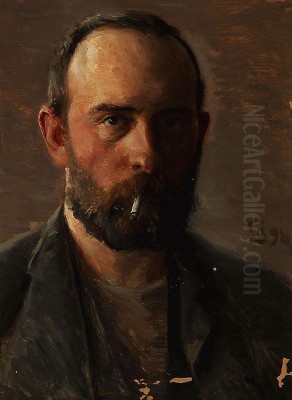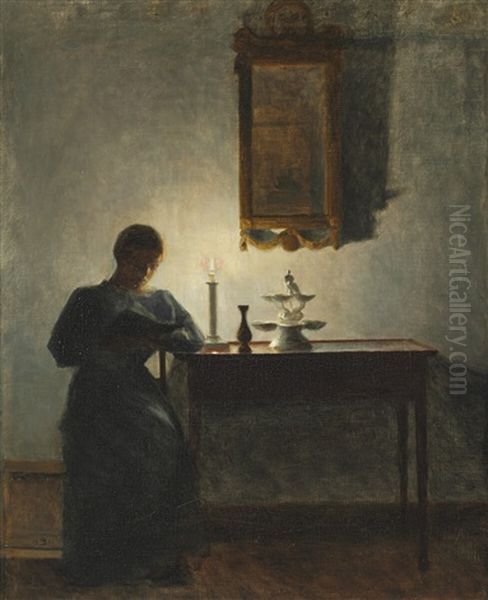
Peter Vilhelm Ilsted stands as a significant figure in Danish art history, celebrated primarily for his evocative paintings and technically brilliant prints depicting serene domestic interiors. Active during the late 19th and early 20th centuries, Ilsted, alongside his close associate Vilhelm Hammershøi, became a leading exponent of what is often termed the 'Copenhagen Interior School'. His work is characterized by a profound sensitivity to light, a muted yet rich color palette, and a quiet, contemplative mood that captures the intimate atmosphere of Danish homes of the era.
Formative Years and Academic Foundation
Born on February 14, 1861, in Sakskøbing, a small town on the island of Lolland, Denmark, Peter Vilhelm Ilsted came from a comfortable background. His father, Jens Peter Ilsted, was a merchant, and his mother was Johanne Sophie Lund. This upbringing likely afforded him the stability needed to pursue an artistic career. His formal artistic training took place at the prestigious Royal Danish Academy of Fine Arts in Copenhagen, the central institution for artistic education in the country.
Ilsted enrolled at the Academy and completed its five-year program, graduating in 1883. During his time there, he would have been exposed to the prevailing academic traditions as well as the emerging currents of Realism and Naturalism that were influencing European art. The Academy was a crucible for Danish talent, and though perhaps less radical than some later movements, it provided a solid grounding in drawing, painting, and composition. It was also here that he likely formed crucial early relationships, including his lifelong connection with Vilhelm Hammershøi.
A Circle of Quietude: The Copenhagen Interior School
The most defining association of Ilsted's career is his connection with Vilhelm Hammershøi (1864-1916) and, to a lesser extent, Carl Holsøe (1863-1935). These three artists, friends and colleagues, developed a distinct approach to painting focused on interior scenes, often sparsely furnished and populated by solitary figures, usually women, engaged in quiet activities or simply absorbed in thought. Their shared aesthetic sensibility led to them being grouped as the principal figures of the 'Copenhagen Interior School'.

The relationship between Ilsted and Hammershøi was particularly close, extending beyond professional camaraderie. In 1891, Ilsted married Ida Lovisa Petersen, who was Vilhelm Hammershøi's sister, making the two artists brothers-in-law. This familial tie undoubtedly fostered a deep personal and artistic dialogue. Hammershøi's influence on Ilsted is undeniable, particularly in the choice of subject matter and the emphasis on atmosphere and light over narrative. Both artists favoured compositions that conveyed stillness and introspection.
However, while often discussed together, their styles possess distinct nuances. Hammershøi's interiors are frequently characterized by a more pronounced sense of austerity, mystery, and psychological distance, often employing a severely restricted, almost monochromatic palette. Ilsted, while sharing the quietude and focus on light, often allowed for more detail, a slightly warmer or more varied palette, and a greater sense of lived-in domesticity. His figures, while contemplative, can sometimes feel less enigmatic than Hammershøi's iconic back-turned women. Carl Holsøe's work aligns closely, also depicting refined interiors with elegant figures, often with a slightly more polished finish than either Ilsted or Hammershøi.
These artists often exhibited together, notably at Den Frie Udstilling (The Free Exhibition), an alternative exhibition society founded in 1891 by artists seeking independence from the established Charlottenborg Spring Exhibition system. This association provided a platform for their shared vision of intimate, light-filled domestic spaces, standing somewhat apart from the brighter, more extroverted styles of contemporaries like the Skagen Painters, such as P.S. Krøyer or Anna and Michael Ancher, who focused on coastal life and plein-air effects.
Painting the Danish Home: Subject and Style
Ilsted's paintings are predominantly interiors. He excelled at capturing the subtle play of light, often daylight filtering through a window, illuminating dust motes in the air and casting soft shadows across floors and walls. His subjects are typically drawn from the everyday life of the comfortable bourgeois home: women reading, sewing, knitting, setting a table, or playing a musical instrument. Figures are often depicted alone or in pairs, absorbed in their tasks, contributing to the overall sense of tranquility and concentration.
His compositions are carefully structured, often using doorways, windows, and furniture to create a sense of depth and spatial harmony. While the rooms feel personal and inhabited, there is an underlying orderliness and calm. The perspective is usually straightforward, inviting the viewer into the scene without dramatic angles. His attention to the textures of materials – polished wood, porcelain, fabric – adds a tactile quality to the visual experience.
His use of color is sophisticated and controlled. While often favouring muted tones – greys, creams, soft browns, and blues – he could achieve remarkable richness and depth through subtle variations and harmonies. The light itself often seems to be the main subject, defining forms and creating the pervasive mood. Works like A Woman Knitting by a Window (1902) exemplify this focus, where the quiet activity is secondary to the atmosphere created by the light streaming in. The Open Door (1910) uses the framing device of a doorway to suggest further quiet spaces beyond, emphasizing the peaceful containment of the home.
Comparisons are often drawn between the Copenhagen Interior School and the Dutch Golden Age masters of the 17th century, particularly Johannes Vermeer and Pieter de Hooch, who also specialized in luminous domestic interiors. While the influence is plausible, Ilsted and his peers were not mere imitators. They translated the preoccupation with light and domesticity into a distinctly modern, late 19th/early 20th-century Danish sensibility, imbued with a specific Nordic quietude and perhaps a touch of Symbolist introspection, differing from the social realism explored by contemporaries like L.A. Ring.
Innovations in Print: A Master Printmaker
Beyond his accomplished paintings, Peter Ilsted achieved significant international recognition as a printmaker, particularly for his mastery of mezzotint and color printing techniques. He explored various methods, including etching and woodblock printing, but it was his work with intaglio processes, especially mezzotint combined with color, that set him apart.
He became highly skilled in the demanding technique of mezzotint, where the entire surface of a copper plate is roughened to hold ink and produce a rich black, and the image is created by scraping and burnishing areas to achieve lighter tones. This process allows for exceptionally soft tonal gradations, perfectly suited to rendering the subtle light effects seen in his paintings.
Furthermore, Ilsted embraced and refined color printing from intaglio plates, notably using the à la poupée technique. This intricate method involves applying different colored inks directly to specific areas of a single printing plate using small pads or dabbers (known as poupées or 'dollies') before each impression is pulled. This differs from multi-plate color printing and requires immense skill and precision in inking to prevent colors from mixing undesirably. It was a relatively rare technique at the turn of the 20th century.
Ilsted's color mezzotints, often reproducing subjects from his paintings, are celebrated for their delicate beauty, subtle color harmonies, and velvety textures. The à la poupée method allowed him to achieve nuanced color transitions that mirrored the soft light and atmosphere of his painted interiors. His printmaking was not merely reproductive; it was a parallel artistic practice where he explored the unique expressive possibilities of the medium. His technical prowess in this field was highly regarded, contributing significantly to his international reputation and placing his prints among the finest examples of the era, comparable in technical ambition, if different in style, to the color prints of artists like Mary Cassatt or the tonal etchings of James McNeill Whistler. One notable example is the print version of Aftenbillede (Evening Scene), depicting his daughters at the piano under lamplight, which successfully translates the painted atmosphere into the print medium.
Travels and Recognition Abroad
Ilsted's artistic horizons extended beyond Denmark. He undertook several study trips abroad, visiting countries such as Italy, Greece, Egypt, Spain, France, and England. These journeys would have exposed him to different artistic traditions, landscapes, and qualities of light, enriching his visual experience, even though his primary subject matter remained rooted in Danish domesticity.
His participation in international exhibitions brought his work to a wider audience and earned him considerable acclaim. He exhibited regularly in Paris, including at the prestigious Salon and the Exposition Universelle (World Fair) of 1890. His successes in Paris were marked by awards, demonstrating the appeal of his quiet aesthetic even in the bustling art capital. He also showed his work in major exhibitions in London (at the Royal Academy), Berlin, Munich, Stockholm, and even in the United States (Chicago).
Within Denmark, his contributions were recognized with the prestigious Eckersberg Medal, awarded to him twice, in 1890 and 1899. This award, given by the Royal Danish Academy of Fine Arts, signified high esteem within his home country. His works began to enter important public collections, both in Denmark (like the Statens Museum for Kunst in Copenhagen and museums in Odense) and internationally (including the Metropolitan Museum of Art in New York and the Musée d'Orsay in Paris), cementing his place in art history.
Later Career and Enduring Influence
Peter Vilhelm Ilsted remained active as an artist throughout his life. Following his marriage to Ida Hammershøi in 1891, his home and family life likely continued to provide inspiration for his art. He also contributed to the artistic community through teaching, eventually holding a position as an assistant professor at the Royal Danish Academy of Fine Arts, the institution where he had trained. This role allowed him to pass on his skills and artistic vision to a younger generation of Danish artists.
He continued to be associated with the Den Frie Udstilling group, participating in their exhibitions and remaining part of the progressive, albeit relatively conservative, wing of Danish art. His dedication to his craft, both in painting and printmaking, remained consistent.
Peter Vilhelm Ilsted passed away in Copenhagen on April 16, 1933, at the age of 72. He left behind a significant body of work that continues to be admired for its technical refinement, atmospheric depth, and sensitive portrayal of intimate domestic life. While perhaps sometimes overshadowed internationally by the more enigmatic Vilhelm Hammershøi, Ilsted holds a secure and respected place in Danish art history.
His legacy lies in his mastery of light and shadow, his contribution to the distinct aesthetic of the Copenhagen Interior School, and his exceptional achievements in the technically demanding field of color mezzotint. His work offers a window into the quiet, ordered world of the Danish bourgeoisie at the turn of the 20th century, captured with a gentle realism and profound sense of peace. He stands alongside figures like Christen Købke from the earlier Danish Golden Age in his sensitivity to the particular qualities of Danish light and atmosphere, yet firmly represents his own time, offering a contemplative counterpoint to the more dramatic or socially engaged art of some of his contemporaries. His paintings and prints remain sought after by collectors and are appreciated for their enduring, quiet beauty.